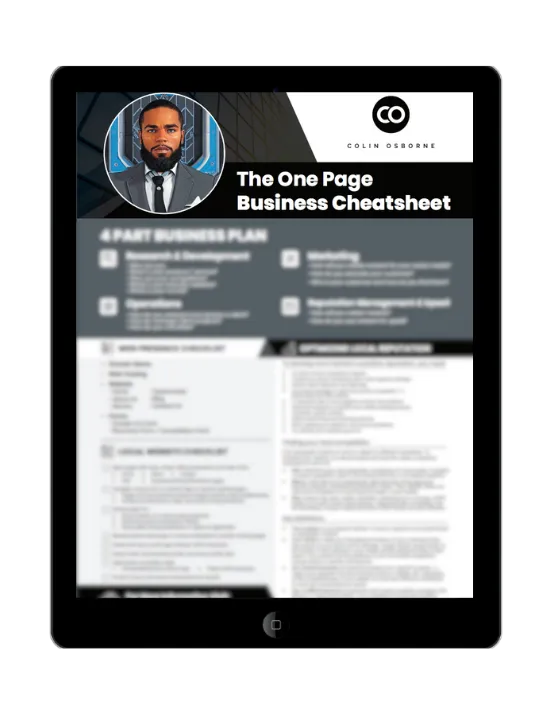Hey, I'm Colin!
Businesses of today are ONLINE
Learn the best marketing solutions, tools, and softwares for starting, running, and growing a small business
Digital Marketing | Automation | Technology
Businesses of today are ONLINE

Learn the best marketing solutions, tools, and softwares for starting, running, and growing a small business
Does this sound familiar?
Daily operations like responding to emails, managing leads, and scheduling appointments take up valuable time. Instead of focusing on growth, you're stuck in manual work that could be automated. By implementing smart automation, you can free up hours and focus on what really matters—scaling your business.
You’re posting on social media, running ads, and sending emails, but leads aren’t converting consistently. Without a clear strategy and automated systems, you’re stuck guessing what works. We help businesses create data-driven marketing automation that attracts, nurtures, and converts leads effortlessly.
You’re using different platforms for CRM, email, scheduling, and payments, but they don’t integrate properly. This leads to missed opportunities, inefficiencies, and lost revenue. We streamline and connect your systems so your business runs smoothly and efficiently.
I Help Business Owners And Entrepreneurs
Create Proven And Effective Digital Marketing Strategies
I Help Business Owners And Entrepreneurs
Create Proven And Effective Digital Marketing Strategies
GET STARTED
where to begin
Resource Center
Before diving into tactics and tools, it is crucial to prioritize and optimize your business's overall marketing strategy. This foundational step sets the stage for effective implementation and ensures that your efforts yield maximum results.
Walkthrough
Get access to over 500+ high quality business, marketing, advertising, and social media marketing videos on my YouTube channel. (And make sure to say "Hi" in the comments!)
Courses
This hands on experience will give you the skills, strategy, and resources that will allow you to confidently create marketing that drives results and the ability to grow ANY business.
Free ebook, The One Page Business Cheatsheet
Gain valuable insights and strategies for business success with our free ebook, "The One-Page Business Cheatsheet." This comprehensive resource is designed to provide entrepreneurs and business owners with essential guidance in a concise and easily digestible format. Discover the power of condensing your business plan onto a single page while still capturing the key elements necessary for growth and profitability. Whether you're just starting out or looking to streamline your existing business, this ebook equips you with practical tips, proven strategies, and actionable steps to optimize your business operations. From goal setting and market analysis to financial planning and marketing strategies, this ebook covers it all. Don't miss out on this valuable resource that can revolutionize the way you approach your business. Download our free ebook, "The One-Page Business Cheatsheet," and unlock the secrets to entrepreneurial success
Gain valuable insights and strategies for business success with our free ebook, "The One-Page Business Cheatsheet." This comprehensive resource is designed to provide entrepreneurs and business owners with essential guidance in a concise and easily digestible format. Discover the power of condensing your business plan onto a single page while still capturing the key elements necessary for growth and profitability. Whether you're just starting out or looking to streamline your existing business, this ebook equips you with practical tips, proven strategies, and actionable steps to optimize your business operations. From goal setting and market analysis to financial planning and marketing strategies, this ebook covers it all. Don't miss out on this valuable resource that can revolutionize the way you approach your business. Download our free ebook, "The One-Page Business Cheatsheet," and unlock the secrets to entrepreneurial success
Do you know the 5 main reasons businesses fail today?
Lack of Automation
Ineffective Marketing Strategies
Poor System Integration
Failure to Adapt to Technology
Inconsistent Customer Experience
INTRODUCING
The #1 Training for Business Marketing Automation

100% risk free - 30 day money back guarantee

Here's what you get:
1:1 personalized coaching with Colin Osborne via DM
Business Planning & Optimization Masterclass
Marketing & Advertising for Small Businesses
Automation & Workflows Strategy Masterclass
Getting Referrals & Repeat Customers
Business- Changing Tactics
20+ Video Lessons Taught by Colin Osborne
Total value: $997
Today Just $297

"Your Best purchase ever!"
"Testimonial lorem ipsum dolor sit amet, consectetur adipisicing elit." - Name






